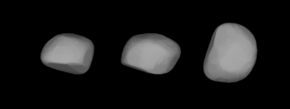
Summary
532 Herculina /hɜːrkjʊˈlaɪnə/ is a large asteroid, with a diameter of around 200 km.
 A three-dimensional model of 532 Herculina based on its light curve | |
| Discovery | |
|---|---|
| Discovered by | Max Wolf |
| Discovery date | 20 April 1904 |
| Designations | |
| (532) Herculina | |
| Pronunciation | /hɜːrkjʊˈlaɪnə/ |
| 1904 NY | |
| Main belt | |
| Adjectives | Herculinian /hɜːrkjʊˈlɪniən/ |
| Orbital characteristics[1] | |
| Epoch 31 July 2016 (JD 2457600.5) | |
| Uncertainty parameter 0 | |
| Observation arc | 111.97 yr (40897 d) |
| Aphelion | 3.26056 AU (487.773 Gm) |
| Perihelion | 2.28601 AU (341.982 Gm) |
| 2.7732838 AU (414.87735 Gm) | |
| Eccentricity | 0.1757028 |
| 4.62 yr (1686.9 d) (1684.34607 d) | |
| 131.03906° | |
| 0° 12m 48.272s / day | |
| Inclination | 16.31351° |
| 107.55583° | |
| 76.09745° | |
| Physical characteristics | |
Mean diameter | 167.791±0.890 km[1] 222.19 km[2] 217.49 ± 5.10 km[3] 191 ± 4 km[4] |
| Mass | (2.29±0.20)×1019 kg[2] (1.15±0.28)×1019 kg[3] (1.0051 ± 0.1108/0.1567)×1019 kg[4] |
Mean density | 4.0 g/cm3[2] 2.12±0.53 g/cm3[3] 2.755 ± 0.304/0.429 g/cm3[4] |
| 9.405 h (0.3919 d)[1] | |
| 0.285±0.029[1] | |
| S[1] | |
| 8.82 to 11.99[5] | |
| 5.92[1] | |
| 0.228" to 0.073" | |
Discovery edit
It was discovered on April 20, 1904, by Max Wolf in Heidelberg, and initially catalogued as 1904 NY.[6] The origin of its name is not known; it may be named after the mythical Hercules, given a feminine form as were all asteroids at the time, or after an unknown woman of that name. The bulk of the asteroids discovered by Wolf around this date were named for characters in operas, but if this name was also drawn from such a source, no explanation has been recorded.
Physical characteristics edit
Herculina is one of the larger members of the main asteroid belt. It is believed to rank among the top 20 in size, but the exact dimensions of many large asteroids are still uncertain. The current estimate for its mass would rank it close to the top 10.
It has often been noted for its complex lightcurves, which made determination of its shape and rotation somewhat difficult. A set of 1982 speckle interferometry observations led to a simple preliminary model of Herculina as a three-axis object, perhaps 260 by 220 by 215 km. 1985 analysis of this data concluded there was a nonspherical shape with one bright spot, whilst a 1987 photometric astrometry study concluded the object was spherical with two dark spots (and rotated around a completely different pole), which was in turn negated by a 1988 thermal study which showed the object could not be spherical. By the late 1980s, the generally accepted model was a three-axis object with major albedo or topographical features.[7]
Recent (2002) modelling of photometric data indicates that Herculina is not spherical, but a blocky shape not unlike a battered cuboid - or, as the analysis described it, it "resembles a toaster". This analysis indicates the presence of multiple largish craters, similar to 253 Mathilde, but no major variation in albedo. The approximate ratios of the axes were suggested as 1:1.1:1.3, broadly consistent with earlier models if slightly more elongated.[8]
Satellites edit
Following anomalous observations during an occultation of the star SAO 120774 in 1978,[9][10] Herculina became the first asteroid to be "confirmed" to have an asteroid moon, with the parent asteroid estimated at a 216 km diameter and a satellite of about 45 km orbiting at a distance of around 1,000 km.[9] However, careful examination in 1993, using the Hubble Space Telescope, failed to locate a secondary.[11]
References edit
- ^ a b c d e f "JPL Small-Body Database Browser: 532 Herculina (1904 NY)" (2008-11-17 last obs). Retrieved 8 May 2016.
- ^ a b c Masses and densities of minor planets Archived 2011-06-04 at the Wayback Machine - Yu. Chernetenko, O. Kochetova, and V. Shor
- ^ a b c Carry, B. (December 2012), "Density of asteroids", Planetary and Space Science, vol. 73, pp. 98–118, arXiv:1203.4336, Bibcode:2012P&SS...73...98C, doi:10.1016/j.pss.2012.03.009. See Table 1.
- ^ a b c Fienga, A.; Avdellidou, C.; Hanuš, J. (February 2020). "Asteroid masses obtained with INPOP planetary ephemerides". Monthly Notices of the Royal Astronomical Society. 492 (1). doi:10.1093/mnras/stz3407.
- ^ "Bright Minor Planets 2005". Minor Planet Center. Archived from the original on 29 September 2008. Retrieved 21 May 2008.
- ^ Provisional elements of the minor planet 1904 NY. J. C. Hammond, Astronomical Journal, vol. 24, iss. 564, p. 105–105 (1904) ADS archive copy
- ^ Speckle interferometry of asteroids (NASA CR-180438). J. Drummond, Steward Observatory, University of Arizona, May 31, 1988
- ^ Models of Twenty Asteroids from Photometric Data. M. Kaasalainen, J. Torppa, and J. Piironen, Icarus 159, 369–395 (2002).
- ^ a b Dunham, David W. (1978). "Satellite of Minor Planet 532 Herculina Discovered During Occultation". The Minor Planet Bulletin. 6: 6–13. Bibcode:1978MPBu....6...13D.
- ^ "Satellites and Companions of Minor Planets". IAU / Minor Planet Center. 17 September 2009. Archived from the original on 21 January 2011. Retrieved 5 April 2010.
- ^ Storrs, Alex; Weiss, Ben; Zellner, Ben; Burleson, Win; Sichitiu, Rukmini; Wells, Eddie; Kowal, Charles; Tholen, David (1999). "Imaging observations of asteroids with Hubble Space Telescope" (PDF). Icarus. 137 (2): 260–268. Bibcode:1999Icar..137..260S. doi:10.1006/icar.1999.6047. Archived from the original (PDF) on 25 February 2012.
External links edit
- 532 Herculina at AstDyS-2, Asteroids—Dynamic Site
- Ephemeris · Observation prediction · Orbital info · Proper elements · Observational info
- 532 Herculina at the JPL Small-Body Database


